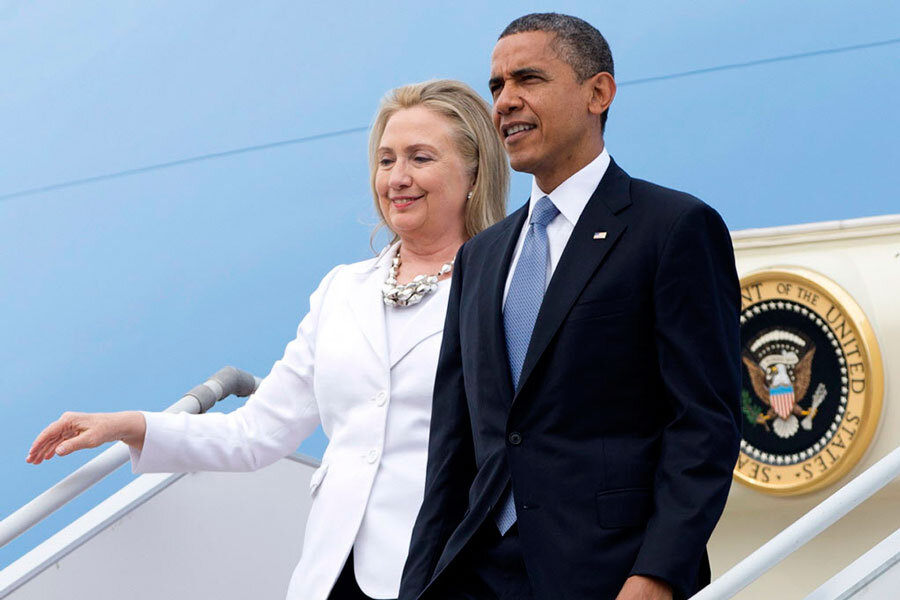Obama hits the trail for Hillary Clinton: Will he help or hurt?
Loading...
| Washington
President Obama is set to hit the campaign trail for Hillary Clinton for the first time, the next step in what Democrats hope is a march to four more years in the White House.
Mr. Obama has been itching to campaign for Mrs. Clinton for a while. But there was this little thing called the primaries that had to play out first. Then there was the Orlando massacre on June 12, which forced the cancellation of their first joint appearance, which was to take place a few days later.
Obama, too, has been mindful of Bernie Sanders, who still hasn’t endorsed Clinton, and of Senator Sanders’s supporters. Still, polls show that most Democrats and Democratic-leaning voters are ready to vote for Clinton, so the big question is turnout. That’s where Obama comes in, beginning Tuesday, when he joins Clinton on stage in Charlotte, N.C. He’s more popular than Clinton, and can (Democrats hope) rally the troops. But Obama also faces risks as a surrogate.
Here’s a list of the ways Obama can both help and hurt Clinton’s candidacy. First, the positives:
He’s better at campaigning. There’s a reason he beat Clinton in 2008, when she was the heavy favorite going in to win the Democratic nomination. He’s the master at soaring rhetoric, and she is all about 10-point plans.
He has higher approval ratings. Obama is more popular than Clinton. His job approval rating is hovering around 50 percent, which is pretty good, considering that he was “under water” for much of the last three years – that is, more voters disapproved of his job performance than approved. Clinton, in contrast, is deeply underwater, seen favorably by only 40 percent of Americans and 56 percent unfavorably. Maybe Obama can offer her some coattails.
As president, Obama still commands the bully pulpit. Presumptive GOP nominee Donald Trump is a master at attracting media attention, but Obama is pretty good at it too. Wherever Obama goes, so do the media – and that’s good for Clinton when he’s campaigning for her. Attracting free media, which amplifies her message at no cost, saves campaign cash for other purposes, such as get-out-the-vote efforts.
Obama can troll Mr. Trump in a way Clinton can’t. Obama clearly loves to make fun of Trump. Remember the White House Correspondents’ Dinner in 2011, when Obama mocked him mercilessly as the real estate mogul sat stone-faced in the audience? Trump had harangued Obama on his place of birth to the point where Obama released his long-form birth certificate just to end the distraction, and at that dinner, Obama got his payback.
Obama has a deeper connection to key constituencies. Obama won the presidency twice in part by winning big among minorities, young voters, and single women. Clinton is beating Trump handily among all three constituencies, but Democrats are concerned about getting those groups excited about turning out. Obama is expected to play an important role in inspiring those groups, especially minorities and Millennials, to show up at the polls.
Obama is sharing his campaign data. The president’s vaunted “data-driven machine,” the operation that elected him twice, is now at Clinton’s disposal – including Obama’s massive email list. That explains all the emails showing up in supporters’ inboxes offering a chance to go see the Broadway musical “Hamilton” with Clinton.
Fundraising. Obama is still a major rainmaker for his party, and that benefits everyone up and down the Democratic ticket.
Now the negatives:
Obama is no longer the ‘change’ candidate. Eight years ago, Obama was the candidate of hope and change. Now an older, grayer Obama represents the status quo, which for some Americans isn’t good, and Trump is the candidate of change. So it will be harder to jazz up crowds.
It’s the Republicans’ ‘turn.’ After two terms of the Democratic Obama, voters would usually be ready for a swing of the pendulum toward the GOP. So Obama and Clinton are trying to buck history. Trump’s inflammatory rhetoric and unorthodox policies give the Democrats hope. But Obama has to be mindful that, in theory, this shouldn’t be a Democratic year.
Obama can’t campaign everywhere. He'll avoid solidly red states. Even in battleground states, the president has to pick his spots, and that probably means avoiding heavily blue-collar areas. Pennsylvania is one example. It’s shaping up to be an important state for Trump, if he’s going to have a shot at winning. But after Obama’s secretly recorded comments during the 2008 campaign about voters in small-town Pennsylvania who “cling to guns or religion,” he should probably steer clear of rural western Pennsylvania and similar areas in the old rust belt.
Obama and Clinton differ on some important policies. Under pressure from Sanders’s unexpectedly strong campaign, Clinton has moved to Obama’s left on issues relevant to working Americans, such as trade and the minimum wage. And she remains more hawkish on military intervention abroad.
In a way, these policy differences help refute the idea that a Clinton presidency would be just a third Obama term. But if voters bring them up during campaign appearances, it could be awkward for both the president and Clinton.
Obama has to beware the Trump trap. Too much trolling could drag the president down.
Bottom line: Obama can do a lot of good for Clinton over the next four months, as he works to convince American voters that they should warm up to her just as he did. But there’s only so much a lame-duck president can do for his hoped-for successor.








